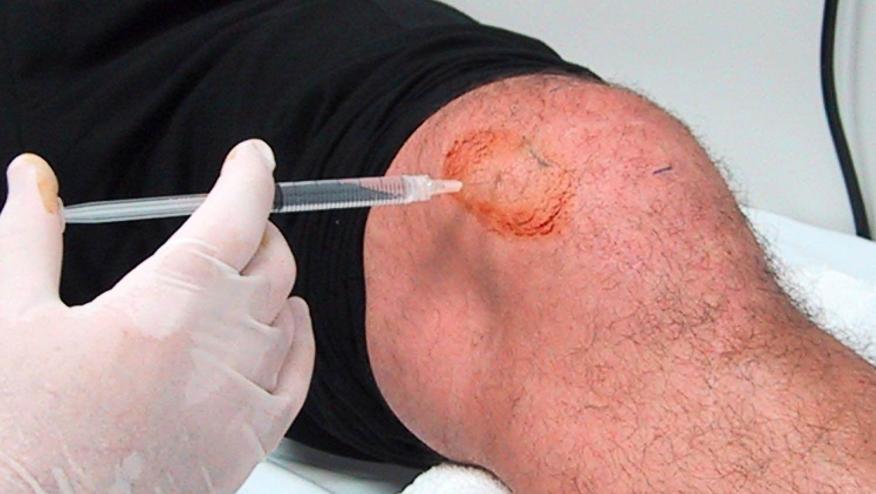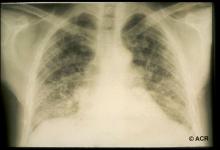Joint Injections: Are They Worth the Risk? Save

Intra-articular injections of corticosteroids for relief of the pain of hip or knee osteoarthritis (OA) may have adverse long-term consequences, researchers suggested.
These injections are commonly performed and have been "conditionally" recommended by the American College of Rheumatology and "should be considered," according to the Osteoarthritis Research Society International. The American Academy of Orthopedic Surgeons, however, has advised clinicians to be on the lookout for emerging evidence for or against the use of intra-articular injections in the knee, explained Ali Guermazi, MD, PhD, of Boston University School of Medicine, and colleagues.
A review published in Radiology.shows that following 459 injection procedures performed during 2018 in a single center, they identified four potential adverse events that should raise concerns, particularly for certain patients:
- Accelerated OA progression, reported in 6% of patients
- Subchondral insufficiency fractures, seen in 0.9%
- Complications of osteonecrosis, in 0.7%
- Rapid joint destruction including bone loss, also in 0.7% of patients
The Background
A Cochrane meta-analysis evaluated 27 trials that included more than 1,767 patients found moderate improvements in pain and slight benefits for physical function following intra-articular corticosteroid injections for knee OA. However, the review noted that the quality of evidence was low, concluding that the results were inconclusive.
"Whether there are clinically important benefits of intra-articular corticosteroids after 1 to 6 weeks remains unclear in view of the overall quality of the evidence, considerable heterogeneity between trials, and evidence of small-study effects," the Cochrane reviewers wrote.
In an editorial accompanying the Boston University report, Richard Kijowski, MD, of the University of Wisconsin in Madison, wrote, "The use of intra-articular corticosteroid injection to treat OA remains commonplace in clinical practice despite the lack of strong evidence supporting its efficacy."
In vitro and animal research has revealed that corticosteroids actually can have negative effects on cartilage. "The action by which corticosteroids are chondrotoxic is complex, but it seems to affect cartilage proteins (especially aggrecan, type II collagen, and proteoglycan) by mediating protein production and breakdown," Guermazi and colleagues explained.
Moreover, the local anesthetics often combined with the steroids also have been linked with chondrolysis.
And a recent retrospective study of 70 patients with hip OA found that 44% of patients who were given injections of triamcinolone with ropivacaine had radiographic progression and 17% experienced collapse of the articular surface.
"Thus, there is a growing body of evidence to suggest that intra-articular corticosteroid injection can accelerate the progression of joint degeneration," Kijowski observed.
The Events
The injection protocol used at Boston University involved 40 mg triamcinolone, 2 mL of 1% lidocaine, and 2 mL of 0.25% bupivacaine.
Accelerated OA progression, characterized by rapid loss of radiographic joint space, was first observed in trials of nerve growth inhibitors, wherein some patients required joint replacement earlier than had been expected. Some experts have suggested that a loss of joint space exceeding 2 mm within a year can be considered accelerated progression, which can be accompanied by effusions, synovitis, and local soft tissue changes.
This accelerated OA progression was seen in 26 patients, following hip injections in 21 patients and knee injections in five.
Subchondral insufficiency fractures were the second type of adverse outcome observed, and were seen in four patients undergoing intra-articular hip injections. This event was previously thought to occur in elderly patients with osteopenia, but has now been reported in younger, active patients who present with acute pain but no apparent trauma.
The affected area often is weight-bearing and may involve loss of cartilage and meniscal tearing. Radiographic findings can be normal or subtle, while on magnetic resonance imaging (MRI) subchondral hypointensity may be detected. If the condition is identified early, before articular collapse has occurred, healing can occur, but once the articular surface has collapsed, the joint must be replaced.
Early identification of subchondral insufficiency fractures also is crucial before intra-articular injections, because the steroid may interfere with resolution of the fracture. Moreover, if an injection is performed and results in pain alleviation, the patient may increase weight-bearing and worsen the insufficiency fracture, hastening collapse.
The third type of event the researchers identified involved complications of osteonecrosis, which typically present with insidious onset of pain or can be asymptomatic. MRI is required for the diagnosis, and can help predict collapse by the extent of osteonecrosis and bone marrow edema. Once collapse has occurred, the only option is joint replacement.
The fourth adverse outcome, rapid joint destruction including bone loss (also referred to as rapidly progressive OA type 2), occurred in two patients with hip injections and one following a knee injection. Some previous authors likened this event to accelerated osteonecrosis, and others have hypothesized that the joint destruction results from undiagnosed subchondral insufficiency fractures.
The Advice
There are currently no recommendations regarding imaging before performing an intra-articular corticosteroid injection, and in some cases, findings may be subtle. "However, given the relative ease of performance and the low cost of radiography, there should be a low threshold to obtain radiographs before performing an intra-articular corticosteroid injection, as the intervention may affect the disease course (i.e., it may result in accelerated progression)," Guermazi and colleagues wrote.
Of particular concern are patients who have no apparent OA or very mild changes on radiographs who have been referred for injections because of pain. In these cases, the indication for injection should be "closely scrutinized," as destructive or rapidly progressive joint space loss tends to develop in patients with severe pain but minimal structural change on radiographs.
"Clinicians should consider obtaining a repeat radiograph before each subsequent intra-articular injection to evaluate for progressive narrowing of the joint space and any interval changes in the articular surface that can indicate subchondral insufficiency fracture or type 1 or 2 rapidly progressive OA," the authors advised.
"We believe that certain patient characteristics, including but not limited to acute change in pain not explained by using radiography and no or only mild OA at radiography, should lead to careful reconsideration of a planned intra-articular corticosteroid injection," the authors concluded, adding that MRI may be helpful in these circumstances.
"Patients might be more than willing to take the small risk of an adverse joint event requiring eventual joint replacement for the possibility of at least some degree of pain relief after intra-articular corticosteroid injection," wrote Kijowski.
"However, patients have the right to make this decision for themselves," he stated.
Guermazi reported being a shareholder of Boston Imaging Core Lab, and having financial relationships with TissueGene, Merck Serono, Pfizer, AstraZeneca, Galapagos, and Roche.
Kijowski reported research funding support from GE Healthcare.







If you are a health practitioner, you may Login/Register to comment.
Due to the nature of these comment forums, only health practitioners are allowed to comment at this time.